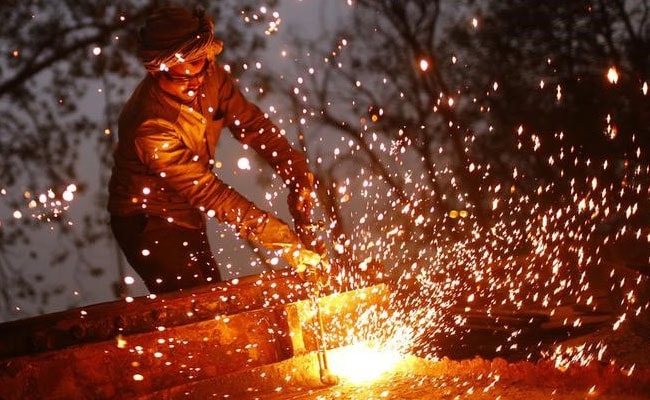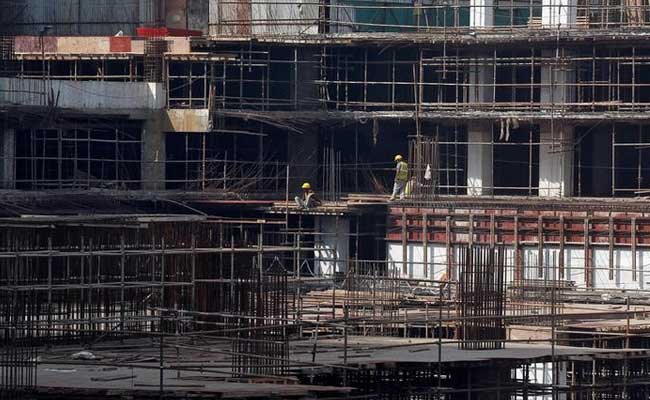Workers in India's construction sector are forced to work under alarmingly hazardous conditions.
New Delhi:
New data released by the government to the parliament on the number of workers killed or injured on construction sites may be dramatically underestimating the scale of such accidents, NDTV has found.
The data - which also includes figures for deaths and injuries of workers engaged in mining and factory work - was released in the Lok Sabha this week in response to a question from Communist Party of India-Marxist lawmaker Sankar Prasad Datta.
But compared to the findings of an NDTV investigation conducted last year to count fatalities and injuries at construction sites, the labour ministry's reply appears to fall far short of reflecting the true scale of the problem.
From 2013 to 2016, the years for which government data overlaps with our investigation, the Labour Ministry reports only 156 deaths and 53 injuries.
 These Lok Sabha replies, however, have no information on Union Territories, Goa, Uttarakhand and from the North Eastern states (excluding Assam).
These Lok Sabha replies, however, have no information on Union Territories, Goa, Uttarakhand and from the North Eastern states (excluding Assam).
For the same period, data collected by NDTV through Right To Information (RTI) requests from state governments gives the number of deaths as 453, nearly three times as many as the number cited in the government reply. The number of injuries as per our count is 212, four times higher (RTI data for Odisha, Himachal Pradesh, Haryana and Jammu and Kashmir was not available to NDTV).
The NDTV report, the result of an investigation spanning five months, was an effort to create a first of its kind database of fatalities and injuries at work sites, an area for which data collection remains patchy.
We filed RTIs across 24 cities in 17 states, as well as sourced data from police departments.
 The government has so far released data to the parliament on deaths at construction sites twice - once in 2015 and then this week.
The government has so far released data to the parliament on deaths at construction sites twice - once in 2015 and then this week.
Adding the data we collected from urban police departments, specifically from Mumbai and Thane, as well as RTI data collected by a Gujarat-based NGO, Bandhakam Mazdoor Sangathan, the gap widens even further. The number of deaths during the same period of 2013-16 climb to 1,090, almost 10 times more than official estimates, while the injuries go up to 389, over six times higher than the number the government disclosed in the parliament.
Curiously, NDTV's data - as well as of the Bandhakam Mazdoor Sangathan - is based on RTI replies, sent by state governments. The Labour Ministry's reply mentions as source the Chief Labour Commissioner.
 Attempts made to get response from the Labour Minister proved unsuccessful.
Attempts made to get response from the Labour Minister proved unsuccessful.
The state-wise break up of deaths and injuries of workers reflects the gross mismatch. For instance, according to the Labour Ministry, there were no deaths in Andhra Pradesh between 2013 and 2016, while the RTI replies to NDTV show that 39 construction workers died in the same period due to accidents.
Similarly, in Delhi, the ministry has recorded only six deaths but the RTI reply to NDTV reports 47 deaths.
Rajeev Gowda, Rajya Sabha MP from the Congress, who has raised the question of workers safety in parliament, told NDTV that "the government cannot speak in two voices here (in parliament)."
"If they provide one set of data to RTI applicants the same data needs to be provided to the members of parliament asking these questions. This is actually highly objectionable and probably in violation of parliamentary accountability so this is something I'll follow up and bring it up in the parliament," he said.
(Sonal Matharu, a former NDTV reporter, who contributed to this report is now a freelance journalist)
The data - which also includes figures for deaths and injuries of workers engaged in mining and factory work - was released in the Lok Sabha this week in response to a question from Communist Party of India-Marxist lawmaker Sankar Prasad Datta.
But compared to the findings of an NDTV investigation conducted last year to count fatalities and injuries at construction sites, the labour ministry's reply appears to fall far short of reflecting the true scale of the problem.
From 2013 to 2016, the years for which government data overlaps with our investigation, the Labour Ministry reports only 156 deaths and 53 injuries.

India's construction sector has bloomed but here has been scant improvement in workers' safety standards.
For the same period, data collected by NDTV through Right To Information (RTI) requests from state governments gives the number of deaths as 453, nearly three times as many as the number cited in the government reply. The number of injuries as per our count is 212, four times higher (RTI data for Odisha, Himachal Pradesh, Haryana and Jammu and Kashmir was not available to NDTV).
The NDTV report, the result of an investigation spanning five months, was an effort to create a first of its kind database of fatalities and injuries at work sites, an area for which data collection remains patchy.
We filed RTIs across 24 cities in 17 states, as well as sourced data from police departments.

Falling from a height is the single biggest reason of deaths among construction workers in India.
Adding the data we collected from urban police departments, specifically from Mumbai and Thane, as well as RTI data collected by a Gujarat-based NGO, Bandhakam Mazdoor Sangathan, the gap widens even further. The number of deaths during the same period of 2013-16 climb to 1,090, almost 10 times more than official estimates, while the injuries go up to 389, over six times higher than the number the government disclosed in the parliament.
Curiously, NDTV's data - as well as of the Bandhakam Mazdoor Sangathan - is based on RTI replies, sent by state governments. The Labour Ministry's reply mentions as source the Chief Labour Commissioner.

In absence of data driving policy, workers are forced to work in hazardous conditions.
The state-wise break up of deaths and injuries of workers reflects the gross mismatch. For instance, according to the Labour Ministry, there were no deaths in Andhra Pradesh between 2013 and 2016, while the RTI replies to NDTV show that 39 construction workers died in the same period due to accidents.
Similarly, in Delhi, the ministry has recorded only six deaths but the RTI reply to NDTV reports 47 deaths.
Rajeev Gowda, Rajya Sabha MP from the Congress, who has raised the question of workers safety in parliament, told NDTV that "the government cannot speak in two voices here (in parliament)."
"If they provide one set of data to RTI applicants the same data needs to be provided to the members of parliament asking these questions. This is actually highly objectionable and probably in violation of parliamentary accountability so this is something I'll follow up and bring it up in the parliament," he said.
(Sonal Matharu, a former NDTV reporter, who contributed to this report is now a freelance journalist)
Track Latest News Live on NDTV.com and get news updates from India and around the world

